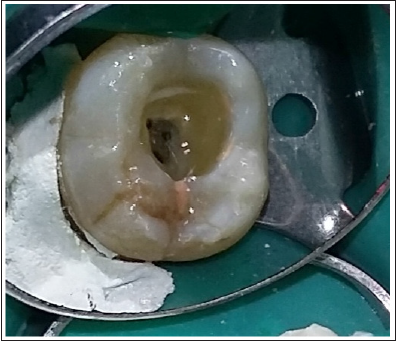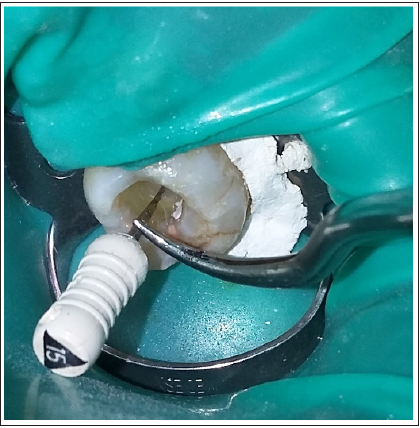- Submissions

Full Text
Modern Research in Dentistry
Passive Ultrasonic Irrigation in Endodontics: A Simple Innovative Technique
Tahir Yusuf Noorani*1,2
1Conservative Dentistry Unit, School of Dental Sciences, Universiti Sains Malaysia, Health campus, 16150 Kubang Kerian, Kota bharu, Kelantan, Malaysia
2Conservative Dentistry Unit, Hospital Universiti Sains Malaysia, Health campus, 16150 Kubang Kerian, Kota bharu, Kelantan, Malaysia
*Corresponding author: Tahir Yusuf Noorani, Conservative Dentistry Unit, School of Dental Sciences, Universiti Sains Malaysia, Health campus, 16150 Kubang Kerian, Kota bharu, Kelantan, Malaysia
Submission: December 03, 2019;Published: December 16, 2019

ISSN:2637-7764Volume4 Issue4
Introduction
Passive ultrasonic irrigation in endodontics
During endodontic treatment is it is nearly impossible to completely clean the root canal system, using conventional endodontic instruments and techniques. This is mainly attributed to the complex anatomy of the root canal. Irrigants such as sodium hypochlorite facilitate the cleaning of the root canal system by its tissue dissolving and antibacterial activity. However, it is effective only when it is brought in contact with the pulp tissue and microorganisms within the root canal system. Passive ultrasonic irrigation is the term used to describe the transmission of acoustic energy from an oscillating K-file or smooth wire to an irrigant in the root canal [1]. Effectiveness of proprietary ultrasonic tips such as Irrisafe ultrasonic tip (Acteon, Merignac, France) or E1 Irrisonic insert (Helse Dental Technology, Brazil) for passive ultrasonic irrigation to improve the cleaning within the root canal system is well documented [2,3]. It is the authors opinion that similar cleaning efficacy can be achieved by using K-file and any conventional ultrasonic dental scaler (Figure 1). The authors believe that this technique is a relatively inexpensive way of carrying out passive ultrasonic irrigation to ensure complete and effective cleaning of the root canal system.
Figure 1: Ultrasonic dental scaler (Satelac, Acteon, France).

The technique involves
A. Achieving anesthesia for the tooth to be treated, isolation, followed by access cavity
preparation.
B. Determining the working length followed by cleaning
and shaping of the root canals using either crown down or step
back technique. Use of sodium hypochlorite as an irrigant during
cleaning and shaping is recommended.
C. After completion of cleaning and shaping, the root canals
are irrigated with 2.5% sodium hypochlorite solution (Figure 2).
Figure 2: Tooth LR7 undergoing root canal treatment. The root canals and pulp chamber flushed with 2.5 sodium hypochlorite solution (HUSM pharmacy, Malaysia).

D. A size 15K-file is inserted into the root canal 1mm short of the working length. Ultrasonic dental scaler is activated and its tip is brought in contact with the shank of the K-file inserted into the root canal (Figure 3) to transmit the ultrasonic energy to the K-file and in-turn to the irrigant present within the root canal system.
Figure 3: A size 15K file (Dentsply, UK) inserted into the root canal and an activated ultrasonic tip brought in contact with the shank of the K file to carry out passive ultrasonic irrigation.

E. Passive ultrasonic irrigation as mentioned in step 4 is
carried out for up to 1 minute for each root canal.
F. Final irrigation with EDTA solution and completion of
the root canal treatment with obturation and appropriate coronal
restoration.
Acknowledgement
Financial support from USM short term grant no. 304/ PPSG/6315195 is highly acknowledged. Support from management of Hospital Universiti Sains Malaysia is also acknowledged.
References
- Van der Sluis LW, Versluis M, Wu MK, Wesselink PR (2007) Passive ultrasonic irrigation of the root canal: a review of the literature. International Endodontic Journal 40(6): 415-426.
- Vivan RR, Duque JA, Alcalde MP, So MV, Bramante CM, et al. (2016) Evaluation of different passive ultrasonic irrigation protocols on the removal of dentinal debris from Artificial Grooves. Brazilian Dental Journal 27(5): 568-572.
- Mozo S, Llena C, Chieffi N, Forner L, Ferrari M (2014) Effectiveness of passive ultrasonic irrigation in improving elimination of smear layer and opening dentinal tubules. J Clin Exp Dent 6(1): e47-52.
© 2019 Tahir Yusuf Noorani. This is an open access article distributed under the terms of the Creative Commons Attribution License , which permits unrestricted use, distribution, and build upon your work non-commercially.
 a Creative Commons Attribution 4.0 International License. Based on a work at www.crimsonpublishers.com.
Best viewed in
a Creative Commons Attribution 4.0 International License. Based on a work at www.crimsonpublishers.com.
Best viewed in 







.jpg)






























 Editorial Board Registrations
Editorial Board Registrations Submit your Article
Submit your Article Refer a Friend
Refer a Friend Advertise With Us
Advertise With Us
.jpg)






.jpg)














.bmp)
.jpg)
.png)
.jpg)










.jpg)






.png)

.png)



.png)






